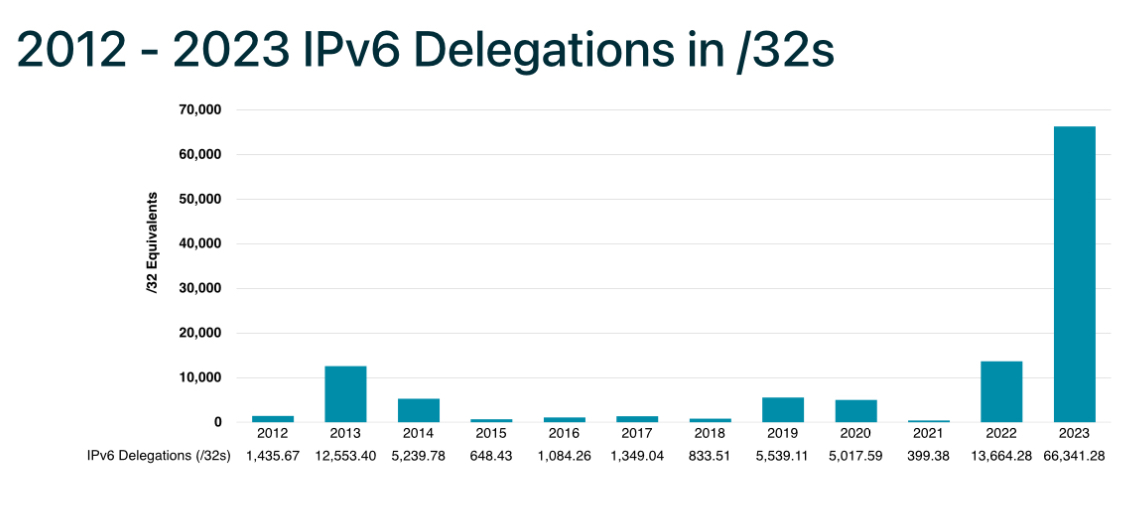Basically what the title says. Here’s the thing: address exhaustion is a solved problem. NAT already took care of this via RFC 1631. While initially presented as a temporary fix, anyone who thinks it’s going anywhere at this point is simply wrong. Something might replace IPv4 as the default at some point, but it’s not going to be IPv6.
And then there are the downsides of IPv6:
- Not all legacy equipment likes IPv6. Yes, there’s a lot of it out there.
- “Nobody” remembers an IPv6 address. I know my IPv4 address, and I’m sure many others do too. Do you know your IPv6 address, though?
- Everything already supports IPv4
- For IPv6 to fully replace IPv4, practically everything needs to move over. De facto standards don’t change very easily. There’s a reason why QWERTY keyboards, ASCII character tables, and E-mail are still around, despite alternatives technically being “better”.
- Dealing with dual network stacks in the interim is annoying.
Sure, IPv6 is nice and all. But as an addition rather than as a replacement. I’ve disabled it by default for the past 10 years, as it tends to clutter up my ifconfig overview, and I’ve had no ill effects.
Source: Network engineer.
Only real world advantage of IPv6:
::1 vs 127.0.0.1
If i had a nickle for every time ive seen ipv6 hate this week id have 2 nickels which isnt much bit its weird that it happened twice.
The only reason i can think of to dislike ipv6 is if i was an authoritarian who hated the p2p capabilities it provoded.
Also go watch apalrd’s video on ipv6 migration u know u can actually spell words in ur ipv6 address.
Upvote for semi-unpopular opinion.
I think you’re wrong about the shortage being ‘solved’ by NAT. NAT is great for LAN and WAN in the developed world, but there are billions of folks in remote developing areas where it’s not much help. It also severely limits the big chunks of address spaces that can be allocated to business, universities, governments, etc. It is not a trivial problem waved away by NAT.
I think it will continue to be a very gradual but relentless rollout of IPv6. Not saying it will be fast. But 30 years from now, if we haven’t destroyed civilization, I suspect IPv4 will be a quaint relic. And IPv6 will never run out of addresses.
There’s a large possibility we’ll run out of IPv6 addresses sooner than we think.
Theoretically, 128-bits should be enough for anything. IPv6 can theoretically give 2^52 IPs to every star in the universe: that would be a 76-bit subnet for each star rather than the required 64 minimum. Today, we (like ARIN) do 32-48-bit allocations for IPv6.
With IPv4, we did 8-24-bit allocations. IPv6 gives only 24 extra allocation bits, which may last longer than IPv4. We basically filled up IPv4’s 24-bits of allocations in 30 years. 281 trillion (2^48) allocations is fairly reachable. There doesn’t seem to be any slowdown of Internet nor IP growth. Docker and similar are creating more reasons to allocate IPs (per container). We’re also still in the early years of interstellar communications. With IPv4, we could adopt classless subnetting early to delay the problem. IPv6’s slow adoption probably makes a similar shift in subnetting unlikely.
If we continue the current allocation trend, can we run out of the 281 trillion allocations in 30 years? Optimistically, including interstellar networks and continued exponential growth in IP-connected devices? Yes. Realistically, it’s probably more than 100 years away, maybe outside our lifetimes, but that still sounds low when IPv6 has enough IPs for assigning an IP to every blade of grass, given every visible star has an Earth. We’re basically allocating a 32-48 bit subnet to every group of grass, and there are not really enough addresses for that.
This is the worst math that ever mathed. IPv4 is 32 bits of address space. IPv6 is 128. That is 2^32 vs 2^128. Not 2^52, which isn’t even wrong it’s just weird, hopefully this is just some weird performance joke. There are enough addresses in ipv6 to address every known atom on earth. We aren’t running out anytime soon. 96 doublings of IPv4s address space is a number you can’t fathom.
That wasn’t what I said. 2^56 was NOT a reference to bits, but to how many IPs we could assign every visible star, if it weren’t for subnet limitations. IPv6 isn’t classless like IPv4. There will be a lot of wasted/unrunused/unroutable addresses due to the reserved 64-bits.
The problem isn’t the number of addresses, but the number of allocations. Our smallest allocation, today, for a 128-bit address: is only 48-bits. Allocation-wise, we effectively only have 48-bits of allocations, not 128. To run out like with IPv6 , we only need to assign 48-bits of networks, rather than the 24-bits for IPv4. Go read up on how ARIN/RIPE/APNIC allocate IPs. It’s pretty wasteful.
So then this is actually a popular opinion? ;)
More popular than I anticipated, but at least somewhat controversial based on the vote ratio.
Which is hilarious because you hit the nail on the head. IPV6 is not new, it would have long ago been adopted if ever it were gonna. Who is still holding out hope….and why? lol
To be fair, I cannot think of a better alternative to Email
This whole debate is so tired. Just use IPv6, it’s 2024 and it’s so fucking easy these days.
I have actually found IPv6 simpler to set up and manage than I thought it would be. As I run at least one or two internet facing services from my home network, which I cannot do with IPv4 because my ISP is fully CGNAT. I even successfully set up my own static IPv6 address on my server so that I can just point my domain name at it and then anything I need I can just hit my domain and it will give the IP address instead of me having to remember it.
I’m a web developer and I’ve never once used an IPv6 address for any circumstance. My ISP doesn’t use IPv6 either in my region (Starlink).
There’s been only one real purpose of v6 that I’ve seen being the reason to switch: v4 running out of available addresses. Never seen anything else about v6 being used as any kind of reason to switch. So the only reason we’d ever go over to v6 is because we have to, not because we want to.
it’s been the default for my smartphone for years. (t-mobile)
Thank you.
I’ve said this repeatedly in many communities and it’s like I killed the golden goose - people lose their minds.
I disable IP6 everywhere - my router NATs everything as it is, why have another protocol running if I don’t use it?
We’ll see what the future brings.
AFAIK, IPv6 does not truely address the router memory concern. With so many more addresses and more bytes-per-address in the tables, i imagine it’s only a matter of time till we are back to such fundamental woes as “where does this packet go”… but i suppose that is limited by the rate that people buy and move ipv6 address blocks.
As a network engineer you should be aware that ipv4 doesn’t have enough addresses (thanks Microsoft and “the internet of things” for this) and that the temporary fix is temporary, all new systems and devices do support ipv6 for a reason. And using ipv4 in the internal networks of a company/facility is absolutely fine if there is equipment that doesn’t, the stuff usually doesn’t need to connect to the outside anyway.
You don’t remember a ipv4 either, you usually connect to stuff with a domain. The ipv4 you remember is probably just the default router website address, as your ipv4 does change regularly, at least the relevant one to the outside.
Btw ASCII is absolutely outdated for the most part, most shit nowadays is done in UTF-8 (Unicode) as ASCII lacks a load of character.
QWERTY is still around because the difference to the other options is basically nonexistent and doesn’t justify the relearning of writing on a PC for millions of people, same with every other keyboard layout commonly used today like QUERTZ or AZERTY.
Currently the fix still holds up, wich is great, but it won’t do so forever, we literally hook up more and more stuff to the internet and everything needs a IP… From the “Smart” light bulb to the newest car receiving radio over the internet, sending emergency messages over the internet and so on. We will someday run out of ipv4 capacity.
Source: same field of word (i btw absolutely understand that its annoying as shit, cause it is, but we won’t get around it some day)
You don’t remember a ipv4 either
172.26.0.37. That’s the IP of the frggin’ Kyocera printer that takes way too many clicks to configure for every new user. And we get new users… about bi-monthly, which you’d think isn’t that bad, but that interface is downright kafkian.
I don’t remember the router’s IP. I more often than not don’t remember the DNS servers. But that thing… that thing I remember.

XD Printers are the bane of humanity. They shouldn’t exist. Its easier to hook up a typewriter with a industrial robot to do printing than some printers, and its cheaper…
You say that something may replace IP4, but it won’t be IP6, then you list a lot of reasons why it can’t be IP6, except all those reasons would apply to whatever that something is also.







